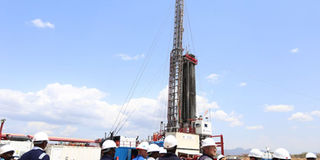Kenya’s future lies in industrialisation

Tullow Oil's Ngamia 3 oil exploration site in Nakukulas Village in Turkana County on July 13, 2014. Oil, gas, mining services, agro-processing, fisheries, leather, textiles and apparel will be important in leading the country to trade-induced industrialisation. PHOTO | BILLY MUTAI | NATION MEDIA GROUP
What you need to know:
- The Economic Report on Africa 2015 takes cognisance of the fact that Africa has the potential to experience growth greater than the East Asian countries through industrialisation.
- Industrial development remains inextricably linked to generating impetus in transforming the Kenyan economy into middle-income status by 2030.
- Trade-induced industrialisation can yield structural transformation in Kenya through inclusive growth, efficient utilisation of resources, and economic diversification.
The prevailing discourse on Africa’s economic development has shifted from whether the region will develop, to how the continent can position itself as the next economic frontier.
The Economic Report on Africa 2015 takes cognisance of the fact that Africa has the potential to experience growth greater than the East Asian countries through industrialisation.
With Africa’s natural resource endowment, it is no wonder that a considerable share of its oil, minerals, and agricultural produce is exported.
Worryingly, however, is that the continent’s performance has been volatile, with short periods of acceleration followed by long spells of deceleration, underscoring serious shortfalls in some areas, notably in the industrialisation and economic diversification of many countries, a case not unique to Kenya.
The recent launch of Kenya’s 10-year Industrial Transformation Programme, which in some quarters has been criticised as being a tad late, informs the government’s stance to pull out all the stops to industrialise the country.
However, this has not been without a few policy concerns.
STRUCTURAL TRANSFORMATION
Industrial development remains inextricably linked to generating impetus in transforming the Kenyan economy into middle-income status by 2030.
The vision — to move manufacturing back to Africa due to high production costs in other traditional markets such as Asia and Europe as well volatile commodity prices — is achievable if the recent plunge of Glencore’s shares, an Anglo-Swiss commodity trading giant, is anything to go by.
However, the gains from industrialisation will be a long time coming if Kenya remains largely dependent on agriculture, continues engaging in a narrow export base with low value products, high trade costs, and inadequate access to global value chains and markets.
Trade-induced industrialisation can yield structural transformation in Kenya through inclusive growth, efficient utilisation of resources, and economic diversification.
This transformation will provide unique opportunities to generate direct and indirect employment, foster strong forward and backward cross-sectoral linkages, and sustain economic growth.
Recent data from the Kenya National Bureau of Statistics indicate a favourable economic outlook for the country.
TRADE-INDUCED INDUSTRIALISATION
However, medium-term prospects indicate risks and uncertainties for the country, with the fragile recovery of the tourism industry amid declining foreign exchange, an unsustainable current account deficit, and tapering of the global commodity prices boom.
It has been widely recognised that Kenya, like many African countries, needs to correct its large trade deficits, innovatively create employment for the working-age population, and consciously design trade policies that will favourably contribute to industrialisation.
At the heart of a country that is aiming for middle-income status by the year 2030, the Industrial Transformation Programme has prioritised 10 flagship projects in sectors where the country has a competitive advantage.
However, agro-processing, fisheries, textiles and apparel, leather, oil, gas, and mining services will be important in leading the country to trade-induced industrialisation.




